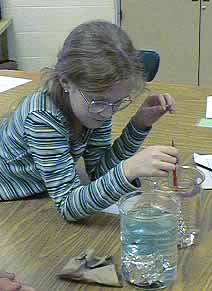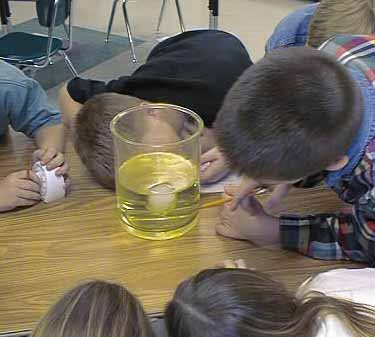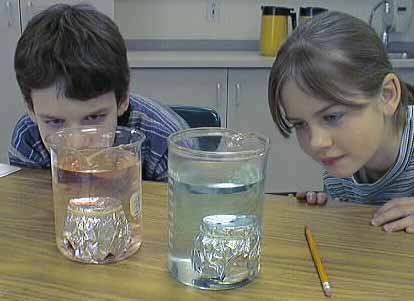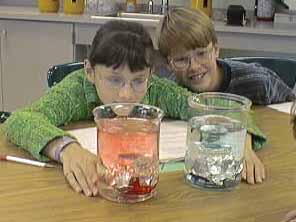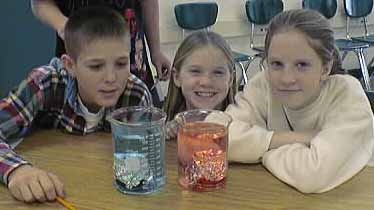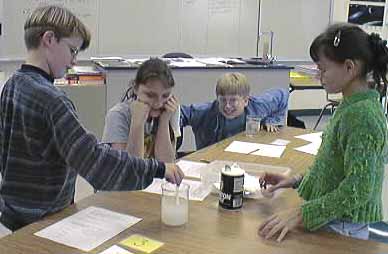 In Mrs. Warman's Science class we did an experiment to try to find out why some things float and other things sink. Our team worked together to find a way to explain the relationship of density to sinking or floating. Ashley first filled a beaker with 200 mL of water. Next, Jessica added just enough salt to the water to make it look cloudy and I stirred the water real good. Jordan took another beaker and filled it with 200 mL of water. We followed the instructions carefully and listened to Mrs. Warman so our experiment would turn out just right. --Ricky C.
Samantha and I worked together to make the sure we had just enough salt in our beaker. We had to write down the amount of water we had in the first beaker because we needed to fill up the second beaker with the same amount. Samantha stirred the salt water vigorously. --Sarah A.
Erica and I worked together to make this experiment work. Erica got the second beaker of water. The first beaker of water was salt water, but the second beaker was plain water. Mrs. Warman wanted us to pour the plain water into the salt water, but we had to do it over a spoon. We had to pour the plain water very, very gently into the salt water. This way it did not mix. This was fun, but it took a little while to make sure you did it just right. Next, Mrs. Warman asked us to take a hard-boiled egg and gently place it into the beaker of water. Do you know what happened? I couldn't believe it. You will have to do this yourself to find out. It was like magic! --Chris N.
Have you ever been swimming in Lake Michigan? Mrs. Warman asked us this question and we all said "yes." What does the water feel like when you are floating on top? What happens to the water temperature when you dive down deeper and deeper? Mrs. Warman wanted us to think about this while we did our next experiment. We looked at warm water and cold water and compared what happened when they met each other. Let me explain. First we took a baby food jar and filled it with hot water, added 6 drops of red food coloring and covered it with aluminum foil. We wrapped a rubber band around the top of the baby food jar. Next, we placed the baby food jar into a large beaker and filled it with cold water. We did the same thing again with another baby food jar, but this time we filled it with cold water and 6 drops of blue food coloring. I put the cold baby food jar into another beaker and filled it with hot water. We had a sharp pencil to poke two holes in the top of the aluminum foil. Do you know what happened? I am tapping the side of the jar very gently. Do you know what happened when the cold water met the hot water? --Samantha G. |
The Dazzling Displays of
Density The sixth graders were very busy today discovering the properties of density. Why do some things float while others sink? Take a peek and discover what we did to answer that question.
What do you think will happen if you place a large ice cube in a container of vegetable oil? What will happen to the ice? Will it sink or float? As the ice cube melts, what happens to the vegetable oil and water? Do they mix together? Mrs. Warman's class made five different observations; immediately after the ice cube was place into the vegetable oil, 3 minutes, 10 minutes, 15 minutes and 20 minutes. Wow! It was fun to watch what happened. Most of us did not predict the result. Do you know what happened? Try it and see. --Dusty A.
Joshua and I did the same experiment that Samantha did and we could see a big difference in the water. The hot water was like smoke coming out of a chimney and the cold water just hovered around the hole in the aluminum foil or sunk down below. --Eleanor V.
This was my favorite experiment. Our team made it work so we could see a lot of things. The red hot water went up to the top and stayed. The blue cold water came up a little and then went back down and stayed at the bottom. --Ashley Z.
This was a great experiment. Our team tried to predict what might happen before we poked the holes in the aluminum foil, but we were not sure. Now, we know that warm water will rise and cold water will sink. I think that has to do with density. Cold water is more dense than warm water. That is why when I swim in Lake Michigan I like to stay on top! --Samantha M.
Mrs. Warman always lets us compare our notes and ideas. We like to see what others did and how they did it so we can try it a different way next time. Now I know why some fish like to stay at the bottom of Lake Michigan. They must like the colder water. --Jessica R. Return to Mrs. Warman's HomePage Do you think you might like to try these experiments? Ask your teacher to help you and discover the properties of density and how to relate this to your experiences you encounter on a daily basis. --Mrs. Warman |


